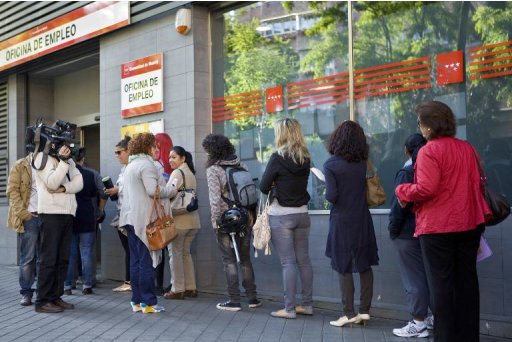 AFP News
AFP News
Spanish jobseekers wait outside an employment office in Madrid, on June 4, 2013. Spain's unemployment rate was 26.2% in July -- the second highest in the eurozone behind Greece
Eurozone unemployment fell for the first time in two and a half years this summer, but with 19 million people jobless analysts say the labour market remains the weak link in recovery.
In a fresh sign of tentative redress from the eurozone crisis, official data showed unemployment dropping to 12.0 percent in July and August, against 12.2 percent in June, the first if albeit timid fall since early 2011.
A separate indicator meanwhile showed eurozone manufacturing activity growing for the third month running in September, but a slight slowdown underlined that recovery remains uncertain.
With the exception of France and Greece, which both contracted, every country surveyed by Markit Economics for their Purchasing Managers' Index showed expansion, with the Netherlands at a two and a half year high, followed by Ireland and Germany.
The labour market however remained "the weak link" in the road to renewed growth, the survey said.
The EU's Eurostat statistics agency said the total number of people out of work in the 17 nations sharing the euro fell by 16,000 in August from the previous month to 19.17 million.
But year-on-year from August 2012 that meant unemployment has climbed by 895,000.
Although dole queues may have stopped lengthening over the summer, officials and analysts stressed that the nascent recovery was too fragile to open the way to a strong pick-up in job creation.
The figures "remind us that a robust economic recovery is not yet a reality," said the EU's employment commissioner Laszlo Andor.
"We still have 26.5 million Europeans jobless, with 5.5 million of them under the age of 25," he added, citing figures for the full 28-member European Union, including Croatia which joined in July.
Across the EU, the unemployment rate remained unchanged at 10.9 percent for the fourth consecutive month.
In the United States in comparison, unemployment stood at 7.3 percent in August, against 7.4 percent the previous month.
The EU jobs data "provided further tentative signs that labour market conditions are improving," said economic Ben May at Capital Economics.
He forecast a continuing improvement over the coming months but cautioned that "with pretty weak growth in the region as a whole, unemployment looks set to fall only very gradually at best."
There was some positive news for youth unemployment, the 16-25 age bracket, which fell in the 12 months to August by 52,000 in the eurozone to 3.45 million, and by 123,000 youngsters in the 28-nation EU to 5.49 million.
But overall youth unemployment continued to be extremely high, with more than one out of every five youngsters in search of a job -- at 23.7 percent in the eurozone and 23.3 percent in the EU, after 23.8 percent and 23.4 percent respectively in July.
Greece was the again the worst affected, with a youth jobless rate of 61.5 percent, while Spain was at 56.0 percent in August.
Among those countries with the lowest unemployment levels, Austria had 4.9 percent in August, followed by Germany, Europe's powerhouse economy, on 5.2 percent.
The highest rates were in twice-bailed out Greece at 27.9 percent -- according to the latest available figures for June -- and Spain, on 26.2 percent.
Over a year, unemployment rose in 16 EU states, dropped in 11 and remained stable in Poland. The sharpest increase was in Cyprus, which saw a rise from 12.3 percent to 16.9 percent and in Greece, from 24.6 percent to 27.9 percent between June 2012 and June 2013.
"Proactive employment policies are crucial at this stage," said the EU's Andor, calling for hiring subsidies, tax cuts and social security contributions on low-paid labour, and better support and training.
No comments:
Post a Comment